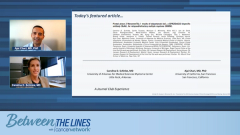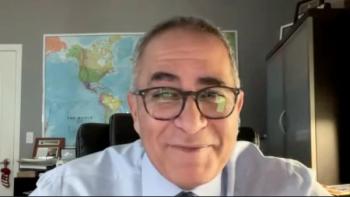
Relapsed/Refractory Multiple Myeloma: An Evolving Treatment Landscape
Closing out their program on relapsed/refractory multiple myeloma, Ajai Chari, MD, and Carolina Schinke, MD, consider optimal treatment strategies in the current landscape and look toward future directions in care.
Episodes in this series

Transcript:
Ajai Chari, MD, PhD: I know in this session we haven’t spent as much time talking about basic management of some of the AEs [adverse effects] of bispecifics, but I would encourage our audience to listen to the Training Academy from Cancer Network, where we talk about CRS [cytokine release syndrome] management, talk about infection management. Because it really does require educating your entire team. It’s not just the physicians, it’s the nurses, nurse practitioners, pharmacists, your consultants. So we encourage you to watch those videos if you have time and interest. I want to just close with we’ve heard a lot of exciting data here from all of these studies. Carolina, what do you think are still the unmet needs in the space with these T-cell–regulation therapies?
Carolina D. Schinke, MD: Well, I think we know they’re very effective and can lead to deep and long responses, but eventually patients still will relapse. So obviously that then creates, again, a patient group that will need further treatment. I think, as we mentioned before, part of it is that we can optimize treatment with bispecific antibodies in terms of maybe improving the scheduling, and the dosing, which can improve efficacy in terms of reducing T-cell exhaustion, but also improve [adverse] effects. Then, obviously, what comes next? That is going to be the big question. If we have now more and more bispecifics coming on the market, how do we sequence those? How can we combine those? Where do we put them in treatment? These are the questions that we’ll have for the next years to come. It’s good. I think we really have a luxury there that we actually have options.
Ajai Chari, MD, PhD: I agree. It’s nice to be having this kind of apparent embarrassment of riches. Also I like to think about unmet needs in terms of patient disease and treatment factors. So I think within patient factors, we probably need more data about frail, elderly [patients with] renal failure. Fortunately, immunotherapies generally have a favorable profile when it comes to renal disease. But we need to generate that data set, and particularly with CAR T’s [chimeric antigen receptor T-cell therapies, where [with] the fludarabine cyclophosphamide conditioning, the fludarabine is renally cleared. So the optimal conditioning regimen needs to be thought about. When it comes to disease factors, we’ve been hearing about unmet needs of ISS [International Scoring System] 3 extramedullary disease. I think one of the concerns from both in efficacy and safety is bulky disease, which is there’s actually ALL literature showing that patients with bulky disease have more CRS [cytokine release syndrome], more [adverse effects], and lower responses. Whether myeloma is also the same, I think there are some data sets that show that marrow greater than 60% maybe are trending a little bit less well. I do caution, especially since I’ve had a patient, even though bispecific, getting [hemophagocytic lymphohistiocytosis], who had bulky disease, 90%. So I think these are not benign drugs and we need to really make sure that we keep our eyes and ears open. Finally, with treatment factors, there’s multidrug refractory, which is where these drugs are going to start. Also, I think the huge unmet need is when you’re having so much data coming out so quickly, is the sequencing issue really what is the right sequence is a really big question. That’s a luxury we can gladly accept because it’s better to talk about sequencing than [have] no options remaining. I think my closing thoughts on this would be that as I’ve left New York and am going to be moving to San Francisco, one of the hardest parts was saying goodbye to patients. I think it was remarkable how many patients we’ve had hospice conversations [with], and we were reflecting that they’re alive and well [and] in some of their deepest remissions. That’s thanks to these really incredible therapies. We’ll turn it to you for any closing thoughts you might have as well.
Carolina D. Schinke, MD: I would agree with you. We’ve had similar here [with] patients’ end-of-life hospice discussions. Then it was just really impressive, not just to the patient, but to us too, to see this kind of response. It was eye-opening. I think it’s great that these drugs now will become available to the whole community, to all patients [with myeloma]. I think it’s just exciting to start using them and getting our own experience. Right now we only have this clinical trial data, but sometimes that’s not really reflective of what we see in the real world. So it’s just exciting for us as oncologists to get our hands on these drugs and then start treating patients and get our own experience. So I’m really excited to do that and [see] how that will also change our practice. I think it’s going to be very exciting to move forward.
Ajai Chari, MD, PhD: Great. Well, I really want to thank my colleague, Dr Schinke, for her participation in this outstanding discussion on an exciting agent. I’d like to thank you all for your participation and engagement in this session and look forward to seeing you again soon.
Carolina D. Schinke, MD: Thank you. Same here, Dr Chari. It was great. Appreciate you.
Transcript edited for clarity.
Newsletter
Stay up to date on recent advances in the multidisciplinary approach to cancer.

















































































